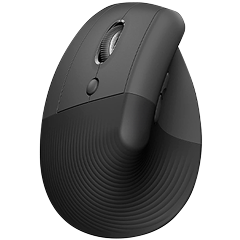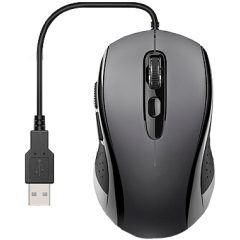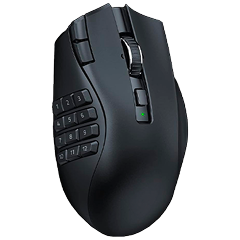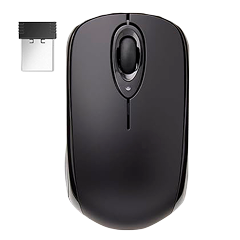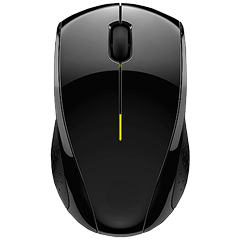En una época en la que todo lo inalámbrico parece estar de moda, podrías pensar que los ratones con cable están desapareciendo poco a poco y se consideran anticuados. Pero la cuestión es que los ratones con cable están lejos de estar obsoletos y, de hecho, para gamers, profesionales y cualquiera que valore la consistencia y la precisión, un buen ratón con cable sigue siendo una de las herramientas más fiables del escritorio.
Hemos preparado esta guía para quienes estén considerando un ratón con cable como su accesorio diario. Ya sea que estén actualizando su estación de trabajo, reemplazando ese ratón OEM desgastado que venía con su portátil o dándole los últimos retoques al equipo de juegos que siempre han deseado. Analizaremos qué hace que un ratón con cable sea excelente, qué buscamos al compararlos y analizarlos, por qué el cable sigue siendo una buena opción, qué características son importantes, cuáles no y, en definitiva, cómo elegir el modelo adecuado para tus necesidades.
¿Por qué elegir un ratón con cable en 2025?
Empecemos por lo obvio: los ratones con cable ofrecen una conexión directa. Esto significa que no hay retardo, interferencias ni pilas: ese es su principal atractivo: un ratón con cable ofrece la máxima fiabilidad. Cuando cada clic, movimiento o gesto debe registrarse exactamente cuando lo deseas, buscas una conexión fiable. Así que, tanto si juegas a un FPS frenético como si simplemente te desplazas rápidamente por las hojas de cálculo, los ratones con cable ofrecen una consistencia que los inalámbricos, incluso los mejores, aún tienen que esforzarse para igualar.
Además del rendimiento y la fiabilidad, también destaca su facilidad de mantenimiento. Con un ratón con cable, no tienes que acordarte de cargarlo, cambiar las pilas, manipular adaptadores ni depender del software. Simplemente lo conectas y funciona. Esto es especialmente práctico si trabajas o juegas durante largos periodos: no te sorprenderá a mitad de la sesión un aviso de batería baja ni se te cortará la conexión repentinamente durante una pelea con un jefe.
Y, por último, está la cuestión del valor. La diferencia se está acortando, pero los ratones con cable siguen ofreciendo, en general, una mejor relación calidad-precio. Si no pagas por la tecnología inalámbrica ni la batería interna, puedes invertir en una mejor calidad de fabricación, sensores más precisos y una ergonomía mejorada.
¿Qué características de rendimiento hacen que un mouse con cable sea bueno?
Antes de empezar a consultar los datos sin procesar y las hojas de especificaciones, lo primero que debes considerar al comprar un ratón con cable es para qué lo vas a usar. Un jugador de FPS competitivo necesita que el sensor del ratón ofrezca resultados muy diferentes a los de un editor de vídeo o un usuario ocasional, por ejemplo.
Todavía hay algunas verdades universales y cosas que tener en cuenta, así que analicemos qué significan esos números en una página de producto y cuáles son importantes en diferentes situaciones.
Primero, hablemos de la calidad del sensor. En ratones para juegos, especialmente, el sensor lo es todo. Busca uno que ofrezca un seguimiento preciso y con buena respuesta, sin vibraciones ni problemas de aceleración. La mayoría de los ratones modernos utilizan sensores ópticos en lugar de las opciones láser más tradicionales, aunque los ratones con estos últimos aún existen y siguen teniendo su lugar.
Los sensores ópticos suelen ser más fiables y consistentes, especialmente en superficies opacas y mate, mientras que los sensores láser funcionan en escritorios brillantes o incluso de cristal. No te dejes engañar por las cifras de DPI exageradas del material de marketing; no necesitas un sensor de 30.000 DPI. Para la mayoría de las personas, un DPI entre 800 y 2.000 será más que suficiente. Los jugadores suelen usar esta configuración un poco más alta para mejorar la respuesta, mientras que los oficinistas pueden apreciar la mayor facilidad de control que ofrece un DPI más bajo, cercano a 800 o incluso ligeramente inferior.
Luego está la tasa de sondeo, que es la frecuencia con la que el ratón informa de su posición al ordenador y puede ser un problema si no se tiene cuidado. Para juegos, una tasa de sondeo de 1000 Hz es el estándar de oro que buscamos al hacer comparaciones, lo que significa que las entradas se comunican al ordenador cada milisegundo.
Esto facilita un movimiento rápido y fluido, ya que el dispositivo tiene mucha información con la que trabajar y no necesita rellenar los espacios. ¡Pero cuidado! Algunos ratones ahora anuncian velocidades de sondeo de 2000 Hz o incluso hasta unos astronómicos 8000 Hz, pero esto no es tan bueno como se esperaba.
No solo será muy difícil notarlo a menos que estés usando lo último en monitores con alta frecuencia de actualización, sino que este nivel de intercambio de información podría causar fallos y ralentizaciones notables a medida que tu procesador intenta seguir el ritmo.
¿Cuán importante es un cable?
Como era de esperar, el cable es tanto la característica distintiva como la mayor preocupación para muchos usuarios de ratones con cable. Sin embargo, podemos tranquilizarlos, ya que la buena noticia es que los ratones con cable modernos han avanzado mucho en este aspecto.
Los ratones de la vieja escuela solían tener cables de goma o plástico, que eran rígidos, propensos a engancharse y podían interferir con la fluidez de los movimientos del ratón. Hoy en día, las cosas han mejorado mucho, más allá de las opciones más económicas del mercado.
Al comprar, busca ratones que se preocupen por mostrar el cable, en lugar de esconderlo. Como mínimo, te recomendamos asegurarte de que tu ratón incluya un cable trenzado. Estos suelen ser más flexibles y mucho más duraderos que las opciones con cubierta de goma.
Si te centras en los videojuegos, muchos ratones con cable de alta calidad incluyen cables ultraflexibles tipo paracord. Estos son más suaves y ligeros que los cables tradicionales, y casi parecen flotar sobre el escritorio.
Aun así, la gestión de cables es importante, e incluso el mejor cable de paracord no puede con un escritorio demasiado desordenado. Obviamente, la solución más sencilla es mantenerlo ordenado, aunque esto no siempre es posible en espacios reducidos o para creadores con varios dispositivos adicionales.
Un amortiguador auxiliar (bungee) para ratón es una solución sencilla que puede ser útil. Mantiene el cable elevado y apartado para que puedas moverte con libertad sin enganches ni resistencia. Suelen ser bastante económicos y sorprendentemente eficaces, sobre todo si usas un ratón con un cable más rígido o juegas a juegos de disparos de alta sensibilidad donde cada movimiento debe ser fluido.
Con cable vs. inalámbrico
Vale la pena detenernos un momento para aclarar brevemente este viejo debate. Los ratones inalámbricos han mejorado enormemente en los últimos años y, actualmente, muchos modelos de gama alta ofrecen una latencia prácticamente indistinguible de la de los ratones con cable.
Si a esto le sumamos una excelente duración de batería, que se mide en días o incluso meses, es fácil entender por qué tantos están dejando de usar el cable. Pero, por cada ratón inalámbrico de gama alta, hay docenas de ratones mediocres que introducen el retraso, las interferencias o las molestias suficientes para volverse realmente frustrantes con el tiempo.
Con los ratones con cable, te garantizamos un rendimiento estable e ininterrumpido. Sin preocupaciones por la batería ni interferencias de conexión, solo una experiencia consistente desde el primer clic hasta el último. Además, está el factor precio: los ratones con cable suelen ser ligeramente más económicos en comparaciones directas con el mismo nivel de rendimiento.
Si bien no podemos negar que los ratones inalámbricos no ganarán cuando se trata de estética de escritorio o comodidad para juegos en el sofá, los ratones con cable siguen siendo la opción preferida por su fiabilidad, simplicidad y rendimiento bruto, especialmente para juegos competitivos.
Forma, tamaño y peso
El rendimiento es, obviamente, importante, pero si el ratón no se siente cómodo en la mano, no disfrutarás usándolo. La comodidad y la ergonomía son aspectos personales, pero hay algunos aspectos clave a considerar en cuanto a la forma y el tamaño.
Los ratones con cable vienen en una amplia gama de formatos, desde carcasas compactas ambidiestras hasta cuerpos ergonómicos grandes y esculpidos. La primera decisión es bastante amplia y depende de tu estilo de agarre. El uso de un agarre de palma, de garra o incluso de punta de dedo determinará qué forma te resultará más natural y cómoda. Los usuarios con agarre de palma suelen preferir formas más grandes y con mayor soporte, mientras que los jugadores con agarre de punta de dedo o de garra suelen optar por diseños más pequeños y ligeros.
El peso también influye, y en este aspecto los ratones con cable suelen ofrecer una ventaja distintiva. Hoy en día, los ratones con cable para juegos son increíblemente ligeros, a menudo con menos de 70 gramos, lo que resulta ideal para juegos de ritmo rápido como CS2, Valorant o Apex Legends, donde se requieren movimientos rápidos y ágiles. Si no juegas de forma competitiva, un ratón más pesado podría resultarte más robusto y cómodo para el uso diario.
Los ratones con cable no son solo para juegos de alto riesgo.
Aunque los ratones con cable suelen ser los más populares en contextos de gaming profesionales, también pueden ser igual de útiles en otras circunstancias. En entornos de oficina, son excelentes por su fiabilidad, especialmente si se trabaja con un ordenador de escritorio y no se quieren saturar los puertos USB con adaptadores ni lidiar con desconexiones aleatorias. Además, muchos ratones con cable son plug-and-play sin necesidad de controladores, lo que los hace ideales para configuraciones compartidas o equipos donde no se puede instalar software.
A qué prestar atención
Esperamos que ya tengas una buena idea de las características que deberías buscar, pero por si acaso, repasemos rápidamente las características o especificaciones que debes tener en cuenta. No todos los ratones con cable son iguales; algunos modelos antiguos o económicos probablemente escatimen en calidad de fabricación o carezcan de ciertas características.
Obviamente, si optas por un ratón con cable, asegúrate de que sea de buena calidad. Busca siempre un cable suave y flexible, preferiblemente trenzado o paracord, con la longitud suficiente para que desaparezca por la parte trasera de tu escritorio hasta tu ordenador. También asegúrate de revisar bien el conector, ya que cada vez más ratones utilizan un conector USB-C en lugar del tradicional USB-A.
Ten cuidado de no pagar de más por un ratón para desbloquear funciones llamativas que simplemente no necesitas. Un número excesivo de DPI o efectos de iluminación RGB exagerados pueden parecer llamativos en el marketing, pero podrían significar que la marca ha recortado gastos en aspectos importantes, como el interruptor o la calidad del material. Si un ratón parece una nave espacial, pero se siente como un juguete, no lo compres.
Además, ten en cuenta que hoy en día es difícil encontrar un hardware que no dependa también del software, y al igual que los propios ratones, no todo el software es igual. Algunas marcas incluyen funciones útiles en su software, lo que puede resultar excesivo, tener errores o ser simplemente molesto en el caso de algunos fabricantes menos conocidos. Si no quieres complicarte con controladores ni paquetes de software, busca ratones que ofrezcan memoria integrada y personalización básica sin necesidad de instalar nada.


